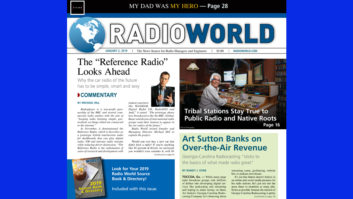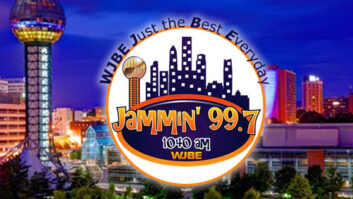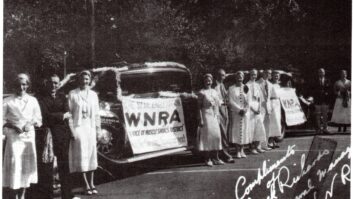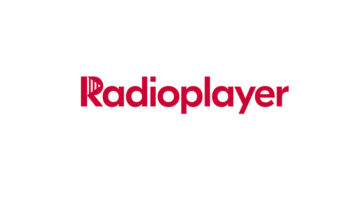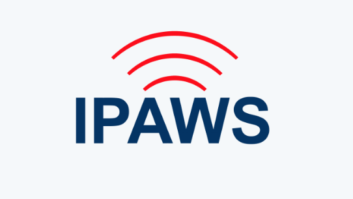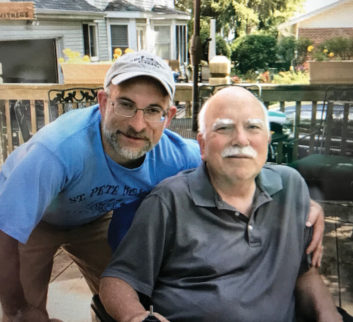 This is a tough article to write; my dad — James “Jim” Withers — was my hero for many reasons, and capturing the entire significance of that statement in the space of this article isn’t possible.
This is a tough article to write; my dad — James “Jim” Withers — was my hero for many reasons, and capturing the entire significance of that statement in the space of this article isn’t possible.
To start, he handled a battle with Muscular Dystrophy with grace, dignity and courage.
He knew what he wanted to do from the time he was five years old. He was an engineer at heart, and much of our bonding was over tinkering with something to make it work, or from him teaching me about how something worked.
He frequently commented that after I was born he knew he was meant to be a father. I had a great dad; I know I was fortunate, as not everyone can say this. He encouraged me to do things that I may not have otherwise done including: water-skiing, glider/pilot lessons, amateur radio and many other pursuits.
He lived a full life and encouraged everyone close to him to do the same.
He was a longtime contributor to Radio World, writing about his first love and what turned into a lifetime working in broadcasting, both as an employee and an entrepreneur.
As many longtime readers will attest, my dad had a knack for making complex topics very approachable. He contributed many articles in this space on subjects ranging from Ohm’s Law; the digital transformation as necessitated by World War II; AM radio; and “Twas the Night at the Site,” a broadcast engineer’s parody on “Twas the Night Before Christmas,” to name just a few. He was a longtime contributor to Radio World, writing about his first love and what turned into a lifetime working in broadcasting, both as an employee and an entrepreneur.
As I started to grow up, Dad began teaching and mentoring, and as I continued growing those lessons were taught as he pursued radio as a side career.
Many times I got to see up close and personal the number of hats an entrepreneur has to wear when building a business. There were invaluable lessons on engineering, accounting, marketing and the value of personal relationships. Dad created many of these relationships on his ability to tell a good story. This is the story of how engineering, business and life shaped the relationship I had with my dad.
It really starts not with a job or a side career at all, but with a connection established when I was in junior high. Dad took a job with an independent TV station down in San Antonio, KABB — Channel 29, and as with most companies, when they realized they needed him, the start date wasn’t tuned to our school year. So he went down ahead of us, and we stayed up in St. Louis so my sister and I could finish out the school year.
HAM RADIO LESSONS
I had just received my novice license and with it my call letters KB0FSO. Shortly after this my dad and mom helped me buy a Hallicrafters radio that I still have in my basement today. It can broadcast at 150 W on 80, 20, 15 and 10 meters.
My dad bought a HeathKit that looked very similar to the Hallicrafters rig and could broadcast on the identical frequencies. He also got his license and received call letters KB5LPK. Most of our early sessions would begin with a phone call where we would make contact and work out what frequency we’d meet each other on. Even with “cheating” like this, it wasn’t always easy to connect with one another.
Then we’d begin the process of coding in a series of dah-dit-dah-dits, letter by letter, what we wanted to say. A very primitive version of today’s text messaging, but a version nonetheless.
I never did graduate beyond thinking of Morse Code letter by letter. We had a neighbor who was a general class and he could code at 25 words per minute, he had a very impressive setup. He talked about how the best coders begin to think in patterns of words. I was 13 or 14 at the time and could never quite make that leap.
My dad had patience with me, and we would finish and sign our call signs and then I’d call him and we’d tell each other goodbye. This usually happened on a weekend or during the lunch hour.
I’ll never forget these sessions or the lessons it taught me. My dad had a way of instilling things in all of us kids. I went on to get QSO cards from people all over the country, many contacted by broadcasting “CQ, CQ, CQ” along with my call sign over and over again. All of them were patient with me. This was before email, before Microsoft was a household name and before phones would become “smart.”
It was a time and a pursuit that had a nobility about it and a certain grounded-ness. I could sit in my bedroom and look out the window and see the dipole antenna that I was transmitting and receiving from; I felt like I was joined to a network of another era. This never changed whether I was broadcasting or just listening to some foreign program from some country far away. I have always felt that there is something magical about radio.
EARLY AUTOMATION
As I started moving through high school, Dad ramped up his business pursuits on the side. He had already managed engineering departments in privately held TV stations as well as network affiliates. While he didn’t leave those positions, he added his love for radio and started a business to build radio automation.
To my knowledge it was his firm and Scott Studios that were competing in the space of radio automation (there were probably others, but I truthfully don’t know who they were).
It was pioneering work because it was in the days of 14.4 and 28.8 kB modems, a large hard drive at that time was 300 MB spinning at 7200 rpm, and they cost in the vicinity of $900.
His package was called RadioMax and primitive versions of it were run with MS-Dos Batch files. Then, many iterations and a couple programmers later, it was supported by Borland and interfaced with Digital IO boards triggering commercials and playlists to run. Perhaps, most importantly, you could upload a playlist and run it on a remote computer. The transmitter sites were outfitted with remote controls that allowed “dialing” and using a touch-tone phone, you could manipulate the on-air computer or the transmitter.
Dad bought a little Mackie mixer and began recording commercials using a closet in our home as a recording studio. His vision was to achieve fully automated remote station management, and he got very close to that goal over the course of several years.
Bandera County, Texas, is a part of south Texas known as the Hill Country, and as many readers will know, height in radio can trump power. One of the first stations that Dad tried to implement RadioMax at reached into Kerrville, Texas, and the transmitter site for that station was appropriately located on a large hill. The first time Dad brought me up there we were greeted by one of Hill Country’s finest, dressed in overalls leaning on a double barrel shotgun.
The transmitter building was a single-wide trailer that had been shelter for everything from raccoons to rattlesnakes, and it would eventually be home to the KEEP(FM) transmitter. For all I know it’s probably still up on that mountain. I watched my dad as he soldered RF components, ran wire, figured out schematics, and frequently, he would look up and say, “You can figure out any circuit if you know Ohm’s law.”
OHM’S LAW & SAGE
I must have heard that a hundred times as I watched and helped him with build that station. He learned about Ohm and RF engineering in the Air Force where he would work on the radar sites that were feeders into the SAGE (Semi Automated Ground Environment) computer that was built by IBM on contract for the Air Force.
This setup was used to track every airplane that entered or exited our national airspace it was quite a technical achievement for the time. Each radar site had a drum disk for data that cost about $90,000 in the late ’60s, and it only held a couple K worth of data.
He would recall how he would start every shift putting a couple pocketfuls of vacuum tubes in his flight jacket because they would burn out on such a regular basis.
It was against this backdrop that he brought experience into radio cabinets both near and far. He really had a gift for buying radio transmitters that were in disrepair and getting them going again.
While military service was ultimately a bit too stuffy for him, I’m convinced that it was his early days in the Air Force that gave him the foundation he needed to pursue a career in broadcasting.
WILL AND SKILL
As my high school years gave away to college, Dad’s radio ambitions continued. In 1996, Dad and some business partners/investors bought into a radio station that was no more than a license and a construction permit in Beaumont, Texas. They ended up purchasing that station for $600K and turning around to sell it for $3.2 million.
The build time from start to on air was about one month, with the vast majority of it happening in two weeks. It was during the build of Beaumont that I realized that the secret sauce to entrepreneurship consists of both will and skill.
It was more than just engineering, too. We met with locals, we worked on marketing, we wired and networked a studio.
The transmitter had three-phase power, which was my first exposure to that kind of power. Residential power, as most of you will know, is standard two-phase, what we know as alternating current, and it makes a kind of square wave of sorts. Three-phase power shifts this square wave so that the period is a third of the standard two-phased equivalent. This three-phase power is produced by piping the AC coming from the utility company into a contraption that looks a little bigger than an upside down propane tank, inside of which is contained a motor spinning to produce power with this phase shifted attribute. It has contacts rotated 120, 240, 360 degrees around the armature of a motor the output from this then heads into the transmitter.
The way Dad explained this to me is that it produces a cleaner power for the transmitter. Truthfully, there’s a lot more engineering involved that is way beyond my ability to describe. My dad went beyond engineering, though, and I remember, while working on this same project, Dad interacting with a guy who came into the studio. We heard stories about how the previous owners owned a NASCAR team and then came up with the game UNO. Radio and business were as much about engineering as they were about stories for my dad; he often connected with people through his ability to tell a story.
VAX COMPUTER
While I started out desiring to do an electrical engineering degree, I took one of my first programming courses on a vax mainframe using the C language. Almost all colleges had a VAX computer when I started my college career, and for many, this was their only computer. My first email address was served from a VAX mainframe computer.
It was my first programming class that convinced me I wanted to write software for a living. My degree became computer science, and I transferred to a school that would allow me to focus on this and provide opportunities for placement afterwards.
I bring this up because over the years as my career necessitated greater focus, my dad and I continued to have a lot of respect for each other’s abilities. He frequently remarked that he didn’t know how I could manage all the interconnectedness of software and its abstractions, and I always struggled to map the details in a schematic onto a board of intricately connected resistors, capacitors, voltage regulators and more.
My dad and I continued to have a lot of respect for each other’s abilities. He frequently remarked that he didn’t know how I could manage all the interconnectedness of software and its abstractions, and I always struggled to map the details in a schematic onto a board of intricately connected resistors, capacitors, voltage regulators and more.
However, as I think back on it, much of the foundation of modern-day networking came from packet radio and the “aloha standard” protocol formed in the Hawaiian Islands. And vacuum tubes were a precursor to the modern day transistor, which was the precursor to integrated circuits, which was the precursor to the microchip, which ultimately provided the basis for the CPU.
So while our career pursuits diverged, much of the foundation of computers and networking was paved by ideas that were discovered in radio. And to think that I started my career right across the street from where the Victor Talking Machine was manufactured in Camden, N.J.!
CORPUS CHRISTI
My dad had a love for the Corpus Christi area. He first drove down to the Gulf of Mexico in October 1989, shortly after moving to San Antonio. After that he never stopped commenting that in October he could be in a T-shirt and cut-offs by the beach.
Those early days led to the acquisition of permits for four radio stations, of which three were granted by the FCC and subsequently built. The fourth wouldn’t get signed on until 2007, and just a little over a year ago I remember him commenting that 20 years ago he would have never believed he would still own a radio station in the year 2017.
I’m helping my mom run KYRK(FM) — “106.5 FM The Shark” — in Corpus Christi, Texas, and have been very thankful for the memories this experience has allowed me to reflect on over this last year.
It’s been a long, hard slog because a month prior to his passing, Hurricane Harvey impacted the tower and the antenna on it, severely affecting our broadcast capability. My dad filed the first STA with me in concert with his FCC attorney in late September 2017, and I renewed in March 2018.
I’m happy to report by the time this article hits the presses, we will be back at 100 percent power. Along the way we came to find out, as we were bringing the main transmitter back to life, that our FM exciter needed to be replaced. I got a quote of $2,800. As you might imagine being a single-station operation, we run a pretty tight balance sheet. So an added $2,800 was not something I was all that enthusiastic about.
I figured I would make a trip to my mom and dad’s house to check out the old garage. Mom and I went nosing around out there — and sure enough we found the shell of an Armstrong FMX 30c exciter out there! In all honesty, it needs a power supply and probably to be bench tested, but that’s not a problem. The treasures found in an RF engineer’s garage!
In 2005, Dad and I took a trip down to Houston and then to Corpus Christi. In Houston we met with a broker who introduced us to one of the inheritors of the King Ranch, which for the uninitiated is a ranch in Texas larger that the state of Delaware (yes, things really are bigger in Texas). It was during and after this meeting that Dad spoke with me about the art of successful negotiation, and about how he hadn’t always negotiated successfully for himself. It was a deal that wouldn’t happen, but it was an impression that was lasting.
I valued my dad’s input on all matters business. He had argued both on the side of management and the union. He did much of his own legal work for the FCC, and often was consulted for his legal expertise.
In later years I valued my dad’s input on all matters business. He had argued both on the side of management and the union. He did much of his own legal work for the FCC, and often was consulted for his legal expertise. He could command a room and yet knew how to make everyone feel at ease.
Most importantly he had a mind that never slept, at the time of his passing he was working on 61 pages of engineering, a book for the family with memories of growing up in Rockhill and Webster Groves, Mo., and he had just completed planning the wedding of my youngest sister.
My dad never suffered from an idle mind, and yet he still made time to take care of and support his family. He gave me encouragement and advice. He had a listening ear and a wonderful sense of humor. He knew how to stay balanced in life and had the ability to maintain a positive outlook, even under the most trying of circumstances.
When he passed away, my sisters Kara, Kayley and I knew one of us had to return to the pages of Radio World to remember the man we thought so highly of, and to perhaps encourage his readers to connect with their sons and daughters, to explore and to never give up hope for a better and brighter tomorrow.
As I think about it, radio and engineering are about these ideals: making something better and, in so doing, leaving the world a little better than you found it.
Radio World joins the author and his family in remembering our friend and contributor Jim Withers.
Ryan James Withers lives with his wife Lisa and their four kids Clayton, Nathan, Madeline and Reagan. He is chief technology officer at 1904labs in St. Louis, Mo. Reach him at [email protected].
Comment on this or any story. Email [email protected].





